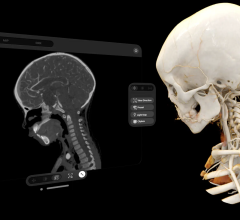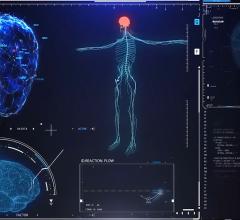
Ceiling- or wall-mounted booms are an ICU solution for organizing equipment to maximize caregiver access to the patient. Photo courtesy of UMass Memorial Health Care (Worcester, MA).
The sheer number of devices involved in the care of critically ill patients can be staggering and includes ventilators, multiple infusion devices, physiologic monitors, point-of-care testing devices, intermittent compression devices, hypo/hyperthermia units and equipment used for management of clinical information — to mention a few. With this growing array of equipment for the care of critically ill patients it becomes increasingly difficult for clinicians in the ICU to navigate a clear path through numerous patient cables, electrical cords and medical gas lines to directly care for the patient. In addition, the various technologies in use generate a wide array of results, reports, alerts and other information, which often have nurses awaiting a turn at workstations in the hallway or nurses' station, instead of spending time at the patient's bedside.
Ironically, many ICUs are finding success in managing this tangle of technology by employing even more technology, geared at organizing bedside devices and bringing ICU nurses back to the bedside. A few such examples are discussed below.
Designing for Patient Accessibility
With many bedside devices taking up floor space and requiring electrical power and medical gases, a key factor in designing efficient ICU patient rooms is organizing equipment in a manner that facilitates care and does not hinder direct access to the patient. Connecting devices to the building utilities on a wall or prefabricated headwall quickly creates a cluttered environment around the patient's head. This becomes particularly problematic during patient code conditions. Service columns placed at the head of the bed allow the bed to be positioned away from the headwall, improving access to the head of the patient.
Commonly used in the OR but finding their way more frequently into the ICU, the newest approach to organizing equipment to maximize patient accessibility is to use ceiling- or wall-mounted booms. Booms allow the care team freedom of movement around the patient and reduce clutter by removing potential tripping hazards from electrical cables, cords and medical gas and vacuum lines. The boom can typically be swung out of the way to allow additional space around the patient, for example, during a code. The flexibility of boom placement provides the following additional advantages:
• Compared to more cluttered ICU designs, the improved accessibility and ability to temporarily move mounted bedside devices away from the patient may better support bedside procedures (e.g., endoscopy, bronchoscopy).
• Easy repositioning of the boom can facilitate placement of additional equipment at the bedside when needed (e.g., diagnostic imaging equipment, portable dialysis machines).
Although some large facilities can support specialized intensive care areas (e.g., medical, surgical, neuro, cardiovascular), most facilities' ICUs must accommodate a mixture of patients with varying clinical needs. ICUs with a diverse patient mix can particularly benefit from the ability to reposition bedside equipment to provide flexible services at the bedside.
Booms, however, can be cost-prohibitive for some facilities, since major renovations to the ceiling structure in most cases is required, in addition to the relatively expensive booms themselves. And in some cases, booms cannot be used because of the existing structure.
Maximizing Nurse-to-Patient Interaction
To maximize the amount of time nurses spend caring for their patient, many technologies are being increasingly used to bring information to the point of care, instead of requiring clinicians to document or retrieve information on workstations at the nurses' station or elsewhere in the care unit or hospital. For example:
• Computers on wheels (COWs) and other portable or mobile computing devices are increasingly being used to access clinical documentation applications and retrieve results at the patient's bedside.
• Many physiologic monitoring systems can be interfaced to other information systems (e.g., laboratory information system, picture archiving and communication system) to allow clinicians to access information such as lab results and radiology images from the patient's bedside through the bedside monitor.
In addition, portable medical equipment is making it possible for more and more care to be provided in the ICU, whereas it may have previously required transport of the patient elsewhere in the hospital.
Mobile diagnostic and therapeutic equipment is increasingly brought directly to the bedside and includes portable radiography and ultrasound equipment, mobile CT (Ceretom by Neurologica is alone in this category), mobile C-arms, video endoscopy and bronchoscopy systems, and portable dialysis units. Bedside care averts the need to transport potentially unstable patients and maintains continuous care by the ICU team — and thus contributes a significant benefit for the well-designed, patient-centric ICU.



 May 01, 2024
May 01, 2024 








